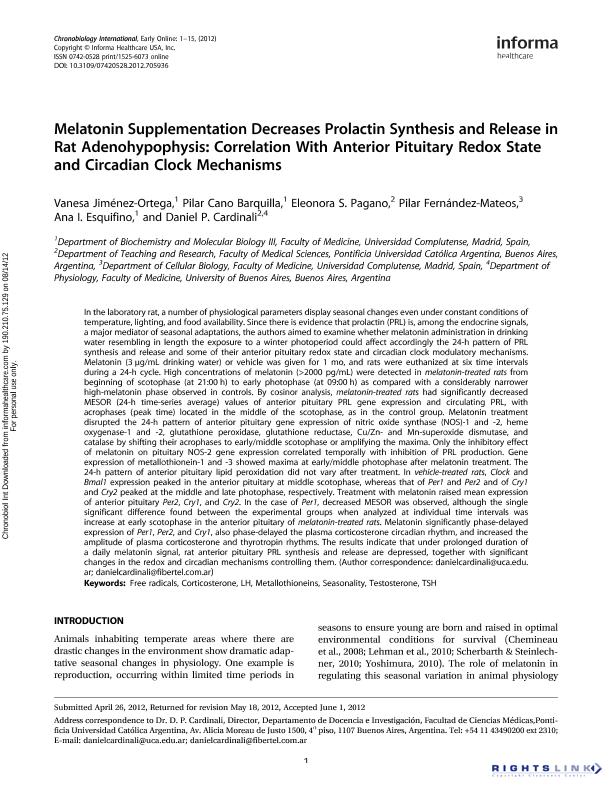Artículo
Melatonin supplementation decreases prolactin synthesis and release in rat adenohypophysis: Correlation with anterior pituitary redox state and circadian clock mechanisms
Jiménez Ortega, Vanesa; Barquilla, Pilar Cano; Pagano, Eleonora Samanta ; Fernández Mateos, Pilar; Esquifino, Ana I.; Cardinali, Daniel Pedro
; Fernández Mateos, Pilar; Esquifino, Ana I.; Cardinali, Daniel Pedro
 ; Fernández Mateos, Pilar; Esquifino, Ana I.; Cardinali, Daniel Pedro
; Fernández Mateos, Pilar; Esquifino, Ana I.; Cardinali, Daniel Pedro
Fecha de publicación:
08/2012
Editorial:
Taylor & Francis
Revista:
Chronobiology International
ISSN:
0742-0528
Idioma:
Inglés
Tipo de recurso:
Artículo publicado
Clasificación temática:
Resumen
In the laboratory rat, a number of physiological parameters display seasonal changes even under constant conditions of temperature, lighting, and food availability. Since there is evidence that prolactin (PRL) is, among the endocrine signals, a major mediator of seasonal adaptations, the authors aimed to examine whether melatonin administration in drinking water resembling in length the exposure to a winter photoperiod could affect accordingly the 24-h pattern of PRL synthesis and release and some of their anterior pituitary redox state and circadian clock modulatory mechanisms. Melatonin (3gmL drinking water) or vehicle was given for 1 mo, and rats were euthanized at six time intervals during a 24-h cycle. High concentrations of melatonin (>2000 pgmL) were detected in melatonin-treated rats from beginning of scotophase (at 21:00h) to early photophase (at 09:00h) as compared with a considerably narrower high-melatonin phase observed in controls. By cosinor analysis, melatonin-treated rats had significantly decreased MESOR (24-h time-series average) values of anterior pituitary PRL gene expression and circulating PRL, with acrophases (peak time) located in the middle of the scotophase, as in the control group. Melatonin treatment disrupted the 24-h pattern of anterior pituitary gene expression of nitric oxide synthase (NOS)-1 and -2, heme oxygenase-1 and -2, glutathione peroxidase, glutathione reductase, CuZn- and Mn-superoxide dismutase, and catalase by shifting their acrophases to earlymiddle scotophase or amplifying the maxima. Only the inhibitory effect of melatonin on pituitary NOS-2 gene expression correlated temporally with inhibition of PRL production. Gene expression of metallothionein-1 and -3 showed maxima at earlymiddle photophase after melatonin treatment. The 24-h pattern of anterior pituitary lipid peroxidation did not vary after treatment. In vehicle-treated rats, Clock and Bmal1 expression peaked in the anterior pituitary at middle scotophase, whereas that of Per1 and Per2 and of Cry1 and Cry2 peaked at the middle and late photophase, respectively. Treatment with melatonin raised mean expression of anterior pituitary Per2, Cry1, and Cry2. In the case of Per1, decreased MESOR was observed, although the single significant difference found between the experimental groups when analyzed at individual time intervals was increase at early scotophase in the anterior pituitary of melatonin-treated rats. Melatonin significantly phase-delayed expression of Per1, Per2, and Cry1, also phase-delayed the plasma corticosterone circadian rhythm, and increased the amplitude of plasma corticosterone and thyrotropin rhythms. The results indicate that under prolonged duration of a daily melatonin signal, rat anterior pituitary PRL synthesis and release are depressed, together with significant changes in the redox and circadian mechanisms controlling them.
Palabras clave:
CORTICOSTERONE
,
FREE RADICALS
,
LH
,
METALLOTHIONEINS
,
SEASONALITY
,
TESTOSTERONE
,
TSH
Archivos asociados
Licencia
Identificadores
Colecciones
Articulos(SEDE CENTRAL)
Articulos de SEDE CENTRAL
Articulos de SEDE CENTRAL
Citación
Jiménez Ortega, Vanesa; Barquilla, Pilar Cano; Pagano, Eleonora Samanta; Fernández Mateos, Pilar; Esquifino, Ana I.; et al.; Melatonin supplementation decreases prolactin synthesis and release in rat adenohypophysis: Correlation with anterior pituitary redox state and circadian clock mechanisms; Taylor & Francis; Chronobiology International; 29; 8; 8-2012; 1021-1035
Compartir
Altmétricas



